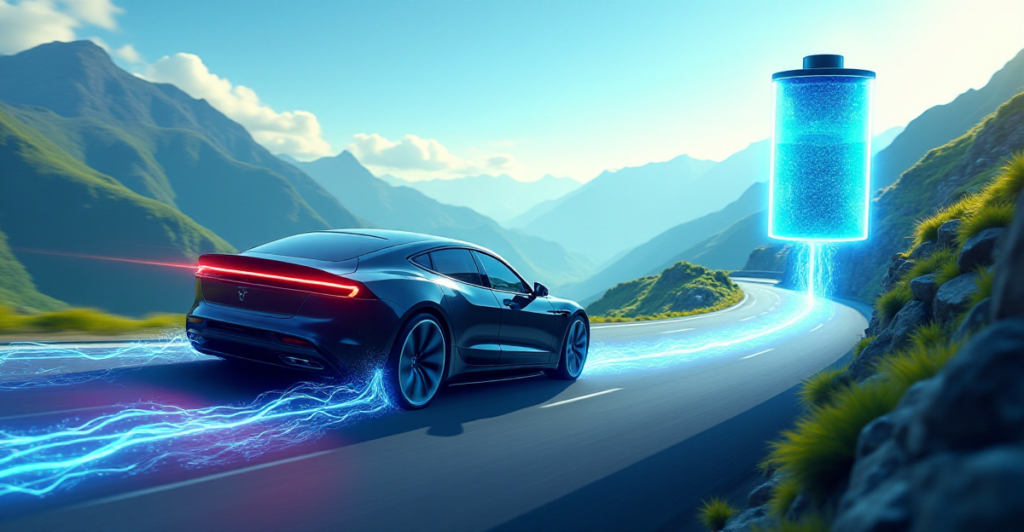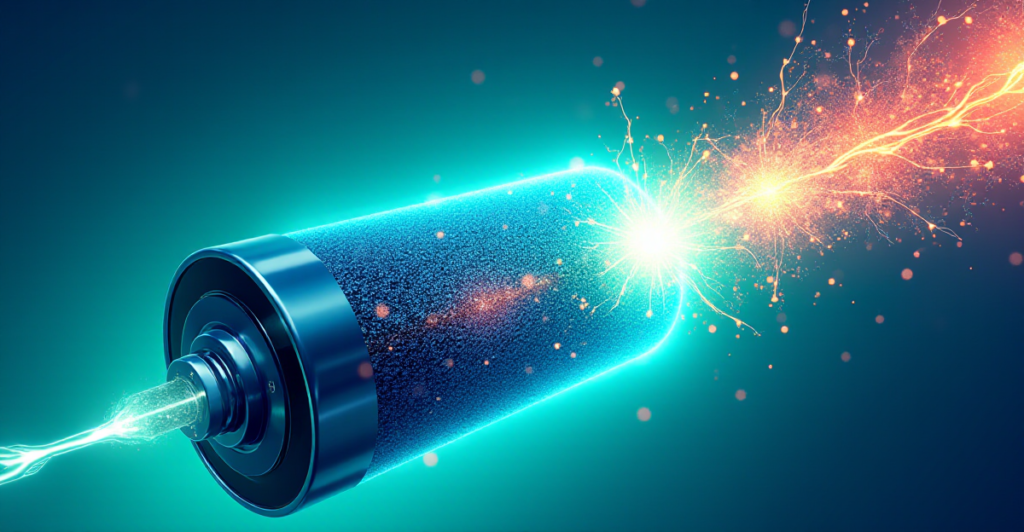Though they are transforming travel, what is the physics behind electric vehicles? I will show in this post how basic physics underlines ideas including energy efficiency, regenerative braking, and battery storage. These realizations will enable you to grasp why electric automobiles are becoming more and more popular as well as how they might help define a sustainable future.
Table of Contents
- How Electric Vehicles Use Physics
- Energy Efficiency and Electric Cars
- The Role of Regenerative Braking
- The Physics of Battery Storage: Powering the Electric Revolution
How Electric Vehicles Use Physics

A fascinating field that clarifies how these vehicles operate and why they are getting more and more popular is physics of electric vehicles. Let’s explore the main physical ideas guiding electric cars and their contribution to a sustainable future.
Understanding the Fundamentals
Operating on the fundamental ideas of electricity and magnetism—which define physics—electric vehicles An electric vehicle’s electric motor—which turns electrical energy into mechanical energy to run the wheels—is its heart. Electromagnetic ideas control this conversion process by means of interactions between an electric current and a magnetic field producing rotational force.
Key Concepts in EV Physics
1. Energy Efficiency: Crucially important for electric cars is their energy economy. Electric motors are far more efficient than internal combustion engines (ICE), which significantly lose mechanical energy from converting chemical energy. This is so because electric motors run with less friction and have less moving components, thereby wasting less energy as heat.
The ground-breaking ability of electric cars is their regenerative braking. The electric motor uses braking to generate electricity from kinetic energy, which stores in the battery. This system increases vehicle range and greatly increases energy economy.
3. Battery Physics: Electric cars depend much on Battery Physics. Commonly used lithium-ion batteries run on electrochemical processes, which control their performance. Chemical energy stored in these batteries is released as electricity when needed.
Energy Efficiency and Electric Cars

Rising in popularity as a more sustainable substitute for conventional gasoline-powered vehicles are electric cars. Driven mostly by their efficiency, electric car technology is a convincing option for those who care about the environment. Examining their amazing energy efficiency and advantages, this blog article will investigate the science underlying electric vehicles.
How Electric Cars Achieve High Energy Efficiency
Electric motors drive electric cars; they directly translate electricity into mechanical energy to propel the vehicle. This method is far more efficient than the combustion engines seen in conventional vehicles. The following are some main explanations for electric automobiles’ higher energy-efficiency:
- Reduced Mechanical Friction: Electric motors have fewer moving parts than combustion engines, resulting in less friction. This means less energy is wasted as heat, leading to a higher efficiency in converting electrical energy into mechanical energy.
- Direct Energy Conversion: Unlike combustion engines, which rely on a complex process of burning fuel to generate power, electric motors directly convert electrical energy into mechanical energy. This direct conversion minimizes energy losses during the conversion process.
- Regenerative Braking: When you brake an electric car, the motor acts as a generator, converting kinetic energy back into electricity to charge the battery. This regenerative braking system captures energy that would otherwise be lost as heat during braking, further enhancing efficiency.
Electric Car Technology and Battery Efficiency
An electric car’s heart is its battery, which stores the electrical energy running the motor. The whole performance and range of an electric automobile depend much on the battery’s efficiency. Here are some salient features:
- Battery Capacity: The battery capacity, measured in kilowatt-hours (kWh), determines how much energy the battery can store. A higher capacity means the car can travel a longer distance on a single charge. For example, a car with a 100 kWh battery can typically travel further than a car with a 50 kWh battery on a single charge.
- Charging Times: The time it takes to charge an electric car depends on the battery’s size and the charging infrastructure. Fast charging stations can significantly reduce charging times, allowing for quicker recharging on the go. However, home charging typically takes longer.
The Benefits of Energy Efficiency in Electric Cars
For drivers, “electric cars’ great energy efficiency results in various benefits that help to create a more affordable and environmentally friendly transportation system:
- Longer Range: By efficiently using the energy stored in their batteries, “electric cars” can travel greater distances on a single charge compared to gasoline-powered vehicles. This eliminates the need to refuel as frequently and allows for longer journeys.
- Reduced Emissions: “Electric cars” produce zero tailpipe emissions, meaning they do not release harmful pollutants like carbon dioxide into the atmosphere. This significantly reduces their environmental impact, contributing to cleaner air and mitigating climate change.
- Lower Operating Costs: Because “electric cars” consume less energy, they require less electricity to travel the same distance. This results in lower electricity bills and reduced fuel costs compared to gasoline-powered vehicles, offering significant cost savings over the long term.
The Future of “Electric Car Technology”
Constant research and development pushing the limits of “electric car technology and performance helps the electric vehicle” sector to change constantly. These fascinating developments will help to define the direction of electric cars:
- Battery Technology Advancements: Research and development are constantly improving battery technology, leading to increased energy density, faster charging times, and longer lifespans. This means batteries can store more energy in a smaller space, leading to more powerful and longer-range “electric vehicles.”
- Faster Charging Infrastructure: The expansion of fast charging infrastructure is making it easier and faster to charge electric cars on the go. This is crucial for long-distance travel and overcoming range anxiety, as drivers can quickly recharge their cars at convenient locations along their route.
- Smart Charging and Grid Integration: Smart charging systems can optimize charging times and costs, even utilizing renewable energy sources to power electric vehicles. This smart grid integration enhances the sustainability and efficiency of electric cars, further reducing their environmental impact.
Unquestionably, the “electric car advantages” make them more appealing to drivers seeking a more affordable and environmentally friendly means of mobility. Electric automobiles are likely to be very important in determining a cleaner and more efficient future for transportation as the globe moves toward a more sustainable one.
The Role of Regenerative Braking

Have you ever considered what happens to the energy wasted when you stop? That energy in a conventional gasoline vehicle is lost as heat. But “regenerative braking” is a secret weapon found in electric cars (EVs). EVs are more ecological and efficient since this innovative system gathers energy during braking and returns it back in the battery. Let’s explore the workings of this novel technology and the reasons behind its revolution of the “electric car technology”.
How Regenerative Braking Works
Consider the electric motor in your EV as a multi-talented artist. It serves as a generator and runs the wheels as well. The motor changes into a generator when you apply the brakes, using the momentum of the vehicle to generate power. The car then returns this electricity to the battery for storage, therefore transforming your car into a mobile power plant. A fundamental part of the “battery physics” behind electric cars is this process sometimes referred to as “regenerative braking”.
Regenerative Braking and the User Experience
The moment you press the brakes, “regenerative braking” will be evident. Often known as “one-pedal driving,” you will feel a mild resistance as the motor gathers energy. You will sense greater resistance the stronger the braking force is. Many EV owners find it simple and fun as it’s a different approach of slowing down.
Consider negotiating a difficult mountain pass. Regenerative braking will cause you to feel the automobile automatically slowing down while also building up your battery. For individuals who depend mostly on the brake pedal, it might be a genuine game-changer and promotes a more effective driving technique. For a customized driving experience, some EVs even let drivers vary the regenerative braking strength.
I recall, for example, driving my EV across the Alps. Regenerative braking came in automatically as I dropped down twisting roads, slowing the vehicle and increasing my range. It was a tremendous eye-opener; I could enjoy a longer trip free from concern about locating a charging station. It resembled having a built-in power booster.
Benefits of Regenerative Braking
“Regenerative braking” has advantages much beyond the improved driving enjoyment. Your pocketbook gains from it as well as the surroundings.
- Extended Range: Regenerative braking essentially turns braking into a charging opportunity. This means you can drive farther on a single charge, reducing the need to constantly hunt for charging stations.
- Improved Energy Efficiency: Instead of wasting energy as heat, “regenerative braking” captures it, significantly improving the energy efficiency of your EV. This translates to less time plugged in and a smaller carbon footprint.
- Enhanced Braking Performance: Regenerative braking provides a smoother, more responsive braking experience. It makes driving feel more controlled and contributes to overall safety on the road.
The Future of Regenerative Braking
With developments on the horizon that will totally transform the automobile sector, “regenerative braking” has an immensely exciting future. Imagine a time when EVs not only run on electricity but also actively help to balance the grid.
- Increased Efficiency: Engineers are constantly working to maximize the efficiency of energy capture during braking, extending the range of EVs even further.
- Smart Braking Systems: The future of regenerative braking involves intelligent systems that use GPS and other sensors to optimize braking strategies based on real-time road conditions. This will allow for more efficient energy recapture in various driving scenarios.
- Integration with Energy Grids: In the near future, regenerative braking systems might be integrated with smart grids, enabling EVs to act as mobile energy storage units. This would allow EVs to contribute to energy storage and distribution, making them even more valuable assets for a sustainable future.
“Regenerative braking” has a bright future that might completely change how we run and run our cars. “Regenerative braking” will be increasingly important as we head toward a more sustainable future in ensuring that electric vehicles are a really feasible and environmentally benign substitute for conventional gasoline automobiles.
The Physics of Battery Storage: Powering the Electric Revolution

Ever wonder how electric vehicles store and release energy to run their motors? Thanks in great part to the intriguing field of “battery physics,” a fundamental component of the “electric vehicle physics” driving the electric revolution. Let’s investigate the science underlying “battery storage,” including battery operation and their impact on the “EV energy efficiency” of electric vehicles.
Unveiling the Secrets of Battery Storage
Imagine a small chemical power plant nestled within your electric automobile. A battery is quite basically what this is. The core of “electric vehicle physics,” electrochemistry magically turns chemical energy into electrical energy. Ionically charged atoms, within a battery, dance between two electrodes separated by an electrolyte. Like a conductor, the electrolyte helps these ions to migrate freely. A potential difference produced by these chemical interactions causes electricity to flow.
Lithium-Ion Batteries: The Powerhouses of Electric Vehicles
“Lithium-ion batteries” are the work horses of the electric vehicle sector. They are well-known for their exceptional longevity, great “energy density”—that is, for putting a lot of power into a tiny area—and great efficiency. Their lengthy lifetime makes them perfect for daily usage and drives our electric adventures.
Let’s explore these batteries’ functioning more closely now:
- Electrodes: Each lithium-ion battery has two electrodes: an anode and a cathode. The anode is usually made of graphite, a familiar material used in pencils, while the cathode can be crafted from various materials like lithium cobalt oxide.
- Electrolyte: The electrolyte is the battery’s conductor, acting like a bridge, allowing lithium ions to travel between the anode and cathode. Think of it as a highway for the ions, facilitating the flow of charge.
- Charging and Discharging: During charging, lithium ions embark on a journey from the cathode to the anode, where they are stored. Imagine it like a tiny chemical storage tank, gathering energy for future use. During discharging, the ions reverse their path, moving back to the cathode, releasing electricity to power the electric motor.
Regenerative Braking: Recovering Energy on the Go
“Regenerative braking is among EV energy efficiency” most clever feature. The electric motor generates electrical energy from the car’s kinetic energy as you slow down or stop. The battery gains charge by means of this energy being returned into it. Consider it as catching the energy wasted while braking and using it later on. Along with extending battery life, this helps to create a more seamless, effective driving experience.
Factors Influencing Battery Performance
The performance of a battery depends on several elements:
- Capacity: “Battery capacity,” measured in kilowatt-hours (kWh), determines how much energy a battery can store. A higher capacity generally translates to a longer “driving range” for an electric vehicle. For instance, a car with a larger “battery capacity” can travel farther on a single charge compared to a car with a smaller capacity.
- Charging Time: The time it takes to fully charge a battery depends on both the “battery capacity” and the charging current. Faster charging stations can significantly reduce “charging time.” You might have experienced the frustration of waiting for your phone to charge, and the same principle applies to electric cars.
- Temperature: Batteries thrive in a comfortable temperature range. High temperatures can degrade the battery’s performance, while very low temperatures can decrease its capacity and charging efficiency. Imagine your battery as a delicate flower, needing the right conditions to bloom.
- Lifespan: A battery’s lifespan is affected by factors like the number of charge-discharge cycles, temperature, and charging habits. Just like any other machine, batteries wear down over time with repeated use.
The Future of Battery Technology: Shaping the Future of Transportation
With continuous developments in battery technology offering a better future for electric vehicles, the realm of “electric car technology” is always changing. Some fascinating future developments abound:
- Higher Energy Density: Scientists are working tirelessly to develop batteries with higher energy density, allowing them to store even more energy in a smaller space. Imagine electric cars with longer driving ranges, making road trips a breeze.
- Faster Charging: New technologies are being developed to enable faster charging, dramatically reducing the time required to recharge an electric car. Imagine pulling into a charging station and being ready to go in minutes!
- Solid-State Batteries: “Solid-state batteries” are emerging as a potential game-changer, offering several advantages over lithium-ion batteries. These batteries boast greater safety, longer lifespans, and even higher energy density, paving the way for a more sustainable and efficient future.
The electric car revolution is driven in great part by these developments in “battery technologies. Battery storage” will be increasingly important as electric vehicles proliferate in determining the direction of transportation, so electric cars are even more practical, reasonably priced, and easily available for everyone. We are only the beginning of an amazing trip.
Conclusion
Driving the electric revolution, the field of “battery storage” is a fascinating universe of “electric vehicle physics.” From knowing how complex lithium-ion batteries are to investigating the possibilities of solid-state batteries and “regenerative braking,” we are seeing amazing developments changing the way we run our cars. These developments are determining the direction of transportation and increasing the accessibility, efficiency, and sustainability of electric vehicles for all. Let us welcome this electric revolution and ride the wave of advancement toward a future marked by more greener living.











